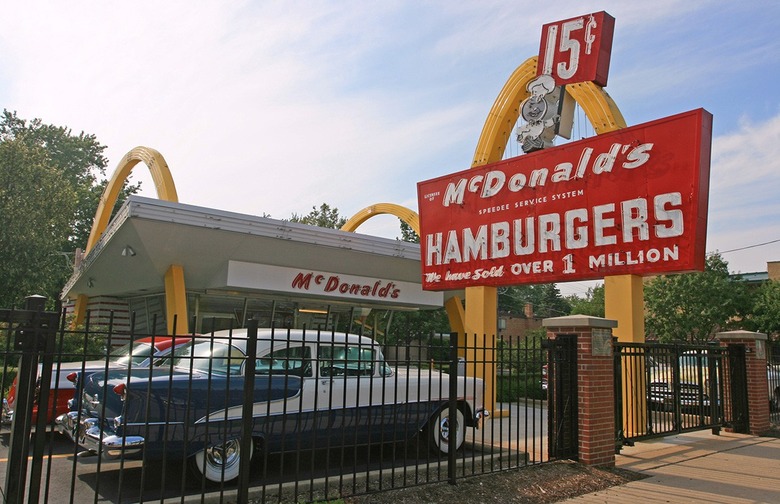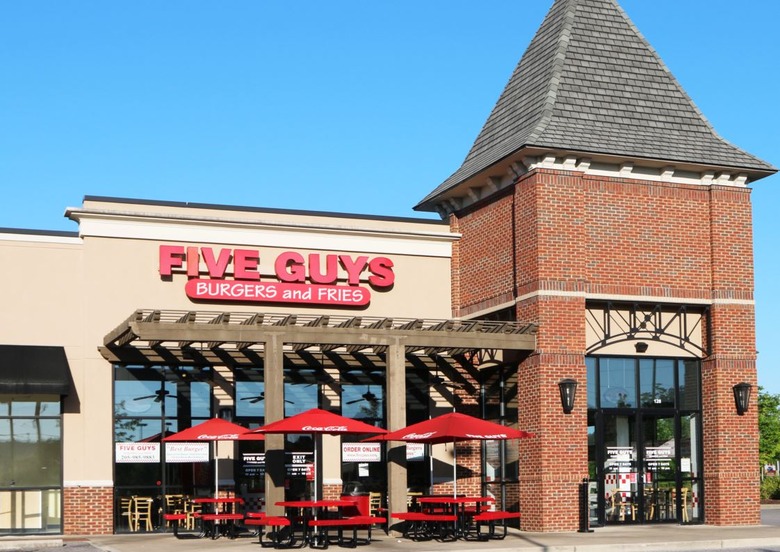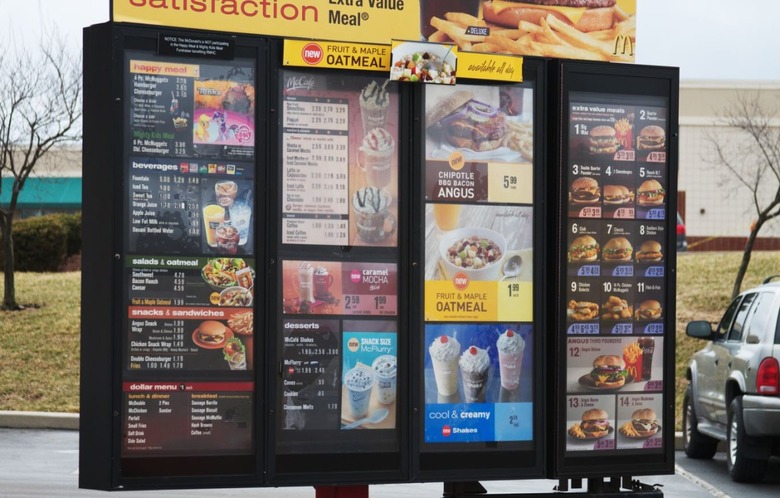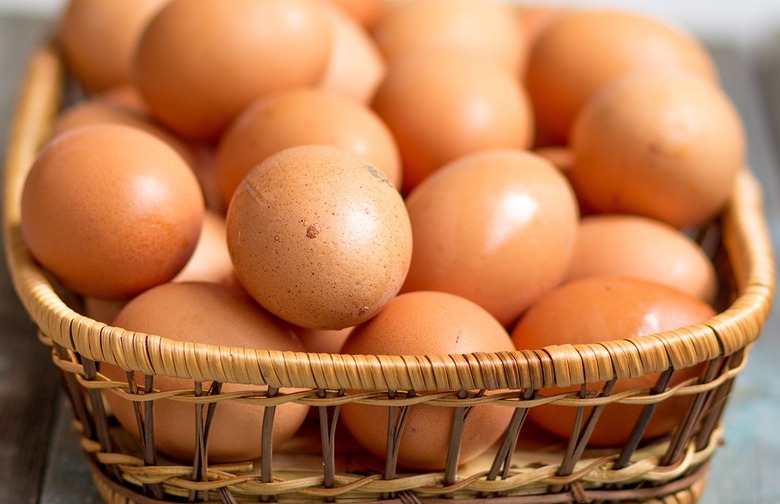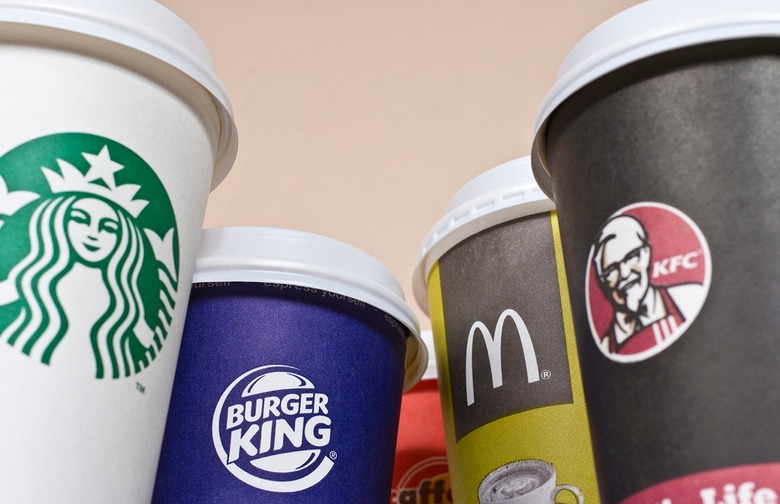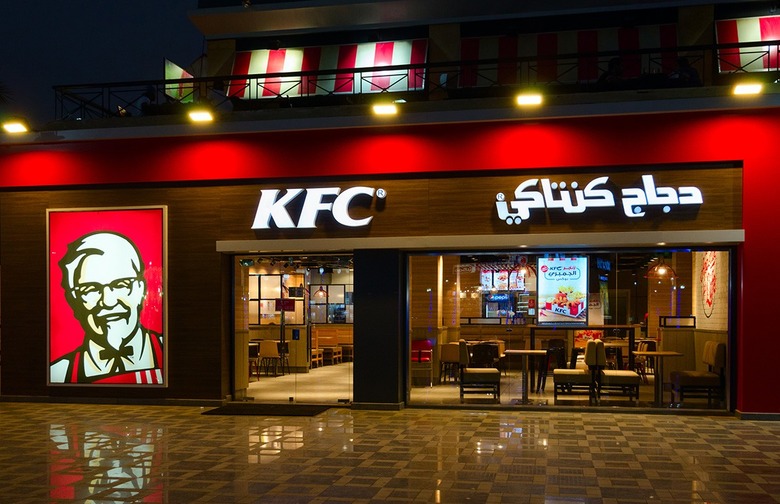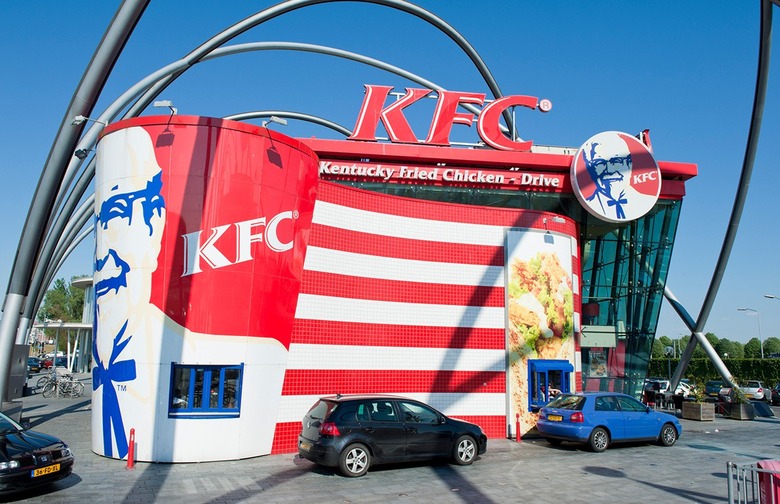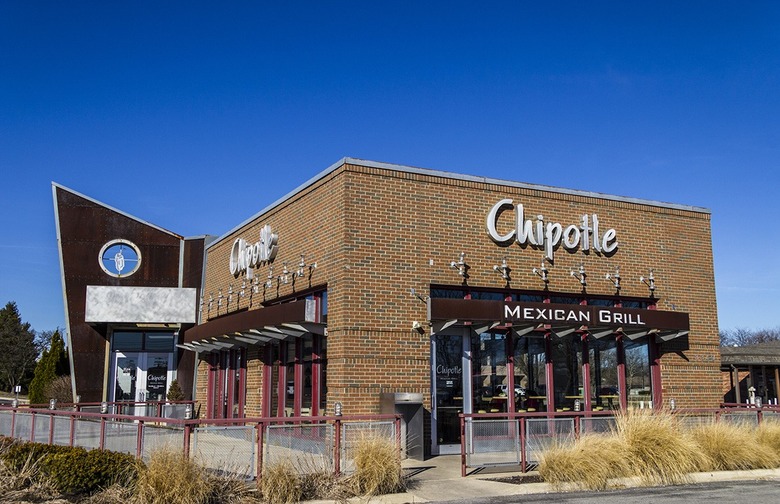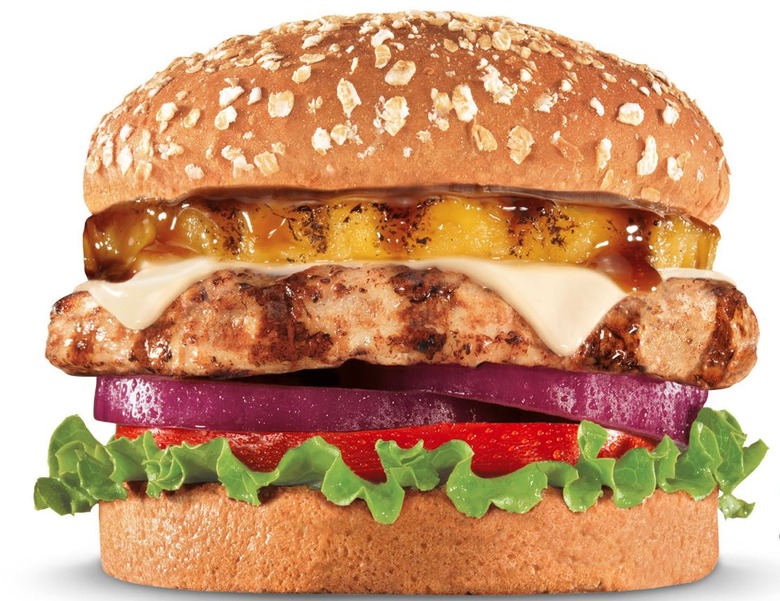How Fast Food Has Changed Since You Were In High School
Fast food has long been an essential part of the American high school experience. It's hard to say which is the more memorable rite of passage — taking your driver's test and actually getting your license, or making that first parent-free drive to the local burger joint with friends to fuel your raging high school appetites. But so many aspects of the fast-food experience have changed dramatically over the years.
While we might get nostalgic about the old fast-food restaurants where we used to spend so much time during our teenage years (possibly even working in them), most of the changes are for the better. We now have more fast-food choices than ever. We actually have some healthy fast-food options now, and these chains continue to find new and interesting ways to serve us. Let's take a look at some of the ways in which the fast-food experience has changed over the past 50 years.
There are A LOT More Chains Today
The fast-food choices in the late 1960s and early 1970s were fairly limited. There were a number of burger options, but Taco Bell was pretty much the only game in town for Mexican-inspired fast food, Dunkin' Donuts was the only widespread doughnut chain, and the options were limited for chicken, subs, and other fare. Oh, how things have changed. Want a sub? You can choose from Subway, Jimmy John's, Jersey Mike's, Potbelly, and myriad other options. Krispy Kreme, Winchell's, and other doughnut chains now compete with Dunkin'. Chipotle, Qdoba, Del Taco, and Baja Fresh are among the Mexican fast-food choices. Shake Shack, Smashburger, Five Guys, and others have joined the burger fray. And there are exciting new fast-casual chains on the rise, including Fuku for fried chicken sandwiches, Cava Grill for healthy Mediterranean fare, Salad and Go for drive-thru salads, and Freshii for salads, wraps, and bowls.
It’s Targeted Less Overtly Toward Children
If you grew up in the 1970s, '80s or '90s, the McDonaldland characters — Ronald McDonald, Hamburglar, Grimace, Mayor McCheese, and others — were part of your childhood. Those characters haven't appeared on television since 2003, but for years they were ubiquitous on commercials that aired during Saturday-morning shows for kids, and they were a staple of McDonald's merchandising. These characters were also prominently featured in the old Playland areas at many of the restaurants. A line of toys soon followed. And McDonald's was hardly the only fast-food chain to target children with its advertising. Burger King has long had its paper crowns, and in the 1990s it did a series of movie tie-ins with Disney. The chains' targeting of children is less overt these days, and McDonald's has taken the lead in offering healthier menu choices for kids, providing apple slices and yogurt options for its Happy Meals.
The Menus Have Gotten Much Larger
The first McDonald's menu included a hamburger, cheeseburger, fries, shakes, and a handful of other drink options. By 1968 the Filet-O-Fish had been added, and the Big Mac made its debut that year. Chicken McNuggets didn't come along until 1983. Now McDonalds' offers an array of burger choices, a variety of breakfast options (including oatmeal), salads, yogurt, and multiple coffee drinks, among other items. Burger King was the rare fast-food restaurant to offer a deluxe burger option back then — it introduced the Whopper in 1957. Taco Bell, which first opened in 1962, didn't offer soft-shell tacos until 1970. Arby's offered only roast beef sandwiches, potato chips, and soft drinks after launching in 1964, adding baked potatoes in 1968. Value menus, a staple of fast-food chains these days, didn't come along until Wendy's introduced one in 1989. Burger King followed with a value menu in 1998, and McDonald's unveiled its Dollar Menu in 2003.
More Chains Are Using Cage-Free Eggs
Fast-food chains are increasingly making it possible to enjoy your eggs without guilt. McDonald's buys some 2 billion eggs in the United States each year. In recent years, McDonald's has been partnering with small farms and ranches that raise free-range chickens, and McDonald's has said that its eggs will be 100 percent cage-free by 2025. Other fast-food chains have made similar commitments. Dairy Queen, Chik-fil-A, Subway, and Taco Bell are among those that have pledged to use only cage-free eggs within the next decade. Wendy's plans to get there soon, with the intention of using entirely cage-free egg sources by 2020.
It’s Become More Eco-Friendly
It's hard to think of fast-food restaurants as being eco-friendly when we so often see discarded fast-food cups, bags, and wrappers along our roads. But some of the bigger chains, including the most iconic fast-food brand of them all, have been trying to do their part for the environment. McDonald's announced in 2013 that all of its American restaurants would start serving hot beverages in paper cups instead of polystyrene (or Styrofoam) cups. Remember when McDonald's burgers came in Styrofoam containers, too? That ended in 1990. McDonald's has also set a timeline for eliminating plastic cups for its cold drinks. Soft-drink chalices will be made with fiber-based packaging from certified or recycled sources. In April, McDonald's announced that it would be getting rid of plastic straws at all of its restaurants in the UK, where the chain operates about 1,300 locations.
It’s Made Its Way Around the World
America has been exporting fast food around the world since the 1970s, and it no longer seems so novel to hear about a McDonald's in Moscow or a Taco Bell in Tokyo. McDonald's operates about 14,000 restaurants in the U.S. and 22,000 abroad, and there are 15,000 KFC restaurants operating internationally and only about 4,000 within the U.S. But, of course, the menu options tend to differ slightly at some of the international locations.
Breakfast Has Become a Must-Have
McDonald's was the first non-doughnut fast-food chain to offer breakfast, putting hotcakes and sausage on the menu in 1972 along with the iconic Egg McMuffin. (The Egg McMuffin was conceived as a way to turn eggs Benedict into a sandwich). It took rival Burger King more than 10 years to follow with its own breakfast menu in 1983. Even chicken-sandwich specialist Chik-fil-A started offering breakfast in 1986. Now breakfast is big business for fast-food chains. Taco Bell made headlines by debuting a breakfast menu in 2014, McDonald's began serving all-day breakfast nationwide a few years ago, and Sonic and Jack in the Box are among the other chains serving breakfast all day long.
Drive-Thru Has Become Commonplace
Surprisingly, McDonald's wasn't the first restaurant to offer drive-thru service. It began in 1947 at a place called Red's Giant Hamburg on Route 66 in Springfield, Missouri. In-N-Out Burger first offered drive-thru service in the Los Angeles area in 1948, and Jack in the Box followed in 1951. The mechanics of drive-thru service haven't changed much over the years — drive up, look at a menu, place your order via speaker, wait in a short line of vehicles while your order is prepared, pay at a window and collect your food — but the number of fast-food places offering drive-thru service has exploded. Panera studied drive-thru service for 10 years before opening one in 2005, taking pains to shield its operations from its counter-serve customers and to develop special packaging. Even Chipotle is introducing drive-thru service, though you can't place your order on-site — you'll have to do that online or with an app before picking it up.
Some Serve Alcohol
Fast-food chains haven't exactly opened full-service bars yet, but some of them are experimenting with serving alcohol. Burger King has high-end "Whopper Bars" in select, high-traffic locations such as South Beach in Miami and Universal City Walk in Orlando. There are fewer food options in these experimental Burger Kings, but diners can enjoy a variety of domestic beers. Chipotle serves beer and margaritas at more than 900 of its American locations. After emerging from bankruptcy in 2014, pizza chain Sbarro began offering alcohol at many of its locations. Shake Shack serves beer and wine, and it even partnered with Brooklyn Brewery to develop a house beer called Shackmeister Ale. And Taco Bell has opened several Taco Bell Cantinas that partner select menu items and shareable appetizers with beer, wine, and frozen drinks.
They’re Relying Less on Preservatives and Artificial Ingredients
Fast-food chains didn't seem to care much about appealing to health-conscious eaters back in our high school days, but that has changed in a major way. McDonald's announced in September that its classic burgers are now preservative-free (and some of its burgers no longer contain pre-frozen beef.) In 2016, it eliminated artificial preservatives from Chicken McNuggets, scrambled eggs, and breakfast sausage, and it removed high-fructose corn syrup from its burger buns. Carl's Jr. and Hardee's began offering the "All-Natural Burger" in December 2014; the burger comes from grass-fed, free-range cattle and has no antibiotics, no steroids, and no added hormones. Carl's Jr. also introduced an all-natural turkey burger line in 2016, using patties made from turkeys raised without antibiotics.
Chains Are Modernizing and Embracing New Technology
The fast-food restaurants of our high school years were often unassuming, quaint-looking places. Today, some of these establishments look like something out of "Blade Runner." McDonald's opened a futuristic-looking restaurant in downtown Chicago that features floating glass gardens, touch screens and 27-foot windows. But technological advancements in the fast-food biz go well beyond high-tech design. In the Chinese city of Hangzhou, diners can pay for their meals simply by smiling. Thanks to facial-recognition software, patrons of this KFC concept outlet can pay by having their faces scanned at an ordering kiosk and entering their phone number. KFC also has a location in Shanghai where customers can place their orders with a voice-activated robot. Diners at this Shanghai KFC are also able to use pay apps to buy their food, and wireless charging stations at each table let them charge their phones while they eat. We can't wait until this technology makes its way to the U.S., and we hope these international chains come along for the ride!
More From The Daily Meal:
Regional Fast Food Chains We Wish Were National
The Best Discontinued Snack Foods From the Decade You Were Born
25 Things You Didn't Know About Your Favorite Fast Food Chains
